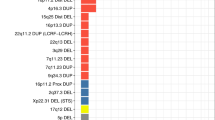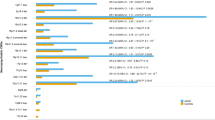Abstract
As part of the International Multi-centre ADHD Genetics project we completed an affected sibling pair study of 142 narrowly defined Diagnostic and Statistical Manual of Mental Disorders, fourth edition combined type attention deficit hyperactivity disorder (ADHD) proband–sibling pairs. No linkage was observed on the most established ADHD-linked genomic regions of 5p and 17p. We found suggestive linkage signals on chromosomes 9 and 16, respectively, with the highest multipoint nonparametric linkage signal on chromosome 16q23 at 99 cM (log of the odds, LOD=3.1) overlapping data published from the previous UCLA (University of California, Los Angeles) (LOD>1, ∼95 cM) and Dutch (LOD>1, ∼100 cM) studies. The second highest peak in this study was on chromosome 9q22 at 90 cM (LOD=2.13); both the previous UCLA and German studies also found some evidence of linkage at almost the same location (UCLA LOD=1.45 at 93 cM; German LOD=0.68 at 100 cM). The overlap of these two main peaks with previous findings suggests that loci linked to ADHD may lie within these regions. Meta-analysis or reanalysis of the raw data of all the available ADHD linkage scan data may help to clarify whether these represent true linked loci.
This is a preview of subscription content, access via your institution
Access options
Subscribe to this journal
Receive 12 print issues and online access
$259.00 per year
only $21.58 per issue
Buy this article
- Purchase on Springer Link
- Instant access to full article PDF
Prices may be subject to local taxes which are calculated during checkout


Similar content being viewed by others
References
Brookes K, Xu X, Chen W, Zhou K, Neale B, Lowe N et al. The analysis of 51 genes in DSM-IV combined type attention deficit hyperactivity disorder: association signals in DRD4, DAT1 and 16 other genes. Mol Psychiatry 2006; 10: 934–953.
Faraone SV, Biederman J, Monuteaux MC . Toward guidelines for pedigree selection in genetic studies of attention deficit hyperactivity disorder. Genet Epidemiol 2000; 18: 1–16.
Smalley SL . Genetic influences in childhood-onset psychiatric disorders: autism and attention-deficit/hyperactivity disorder. Am J Hum Genet 1997; 60: 1276–1282.
Faraone SV, Perlis RH, Doyle AE, Smoller JW, Goralnick JJ, Holmgren MA et al. Molecular genetics of attention-deficit/hyperactivity disorder. Biol Psychiatry 2005; 57: 1313–1323.
Li D, Sham PC, Owen MJ, He L . Meta-analysis shows significant association between dopamine system genes and attention deficit hyperactivity disorder (ADHD). Hum Mol Genet 2006; 15: 2276–2284.
Kuntsi J, Neale BM, Chen W, Faraone SV, Asherson P . The IMAGE project: methodological issues for the molecular genetic analysis of ADHD. Behav Brain Funct 2006; 2: 27.
Fisher SE, Francks C, McCracken JT, McGough JJ, Marlow AJ, MacPhie IL et al. A genomewide scan for loci involved in attention-deficit/hyperactivity disorder. Am J Hum Genet 2002; 70: 1183–1196.
Ogdie MN, Macphie IL, Minassian SL, Yang M, Fisher SE, Francks C et al. A genomewide scan for attention-deficit/hyperactivity disorder in an extended sample: suggestive linkage on 17p11. Am J Hum Genet 2003; 72: 1268–1279.
Faraone SV, Doyle AE, Lasky-Su J, Sklar PB, D'Angelo E, Gonzalez-Heydrich J et al. Linkage analysis of attention deficit hyperactivity disorder. Am J Med Genet B Neuropsychiatr Genet 2007; e-pub ahead of print 14 December 2007.
Bakker SC, van der Meulen EM, Buitelaar JK, Sandkuijl LA, Pauls DL, Monsuur AJ et al. A whole-genome scan in 164 Dutch sib pairs with attention-deficit/hyperactivity disorder: suggestive evidence for linkage on chromosomes 7p and 15q. Am J Hum Genet 2003; 72: 1251–1260.
Hebebrand J, Dempfle A, Saar K, Thiele H, Herpertz-Dahlmann B, Linder M et al. A genome-wide scan for attention-deficit/hyperactivity disorder in 155 German sib-pairs. Mol Psychiatry 2006; 11: 196–205.
Arcos-Burgos M, Castellanos FX, Pineda D, Lopera F, Palacio JD, Palacio LG et al. Attention-deficit/hyperactivity disorder in a population isolate: linkage to loci at 4q13.2, 5q33.3, 11q22, and 17p11. Am J Hum Genet 2004; 75: 998–1014.
Friedel S, Saar K, Sauer S, Dempfle A, Walitza S, Renner T et al. Association and linkage of allelic variants of the dopamine transporter gene in ADHD. Mol Psychiatry 2007; 12: 923–933.
Neale BM, Sham PC, Purcell S, Banaschewski T, Buitelaar J, Franke B et al. Population differences in the International Multi-centre ADHD Gene Project. Genet Epidemiol 2007; e-pub ahead of print 14 September 2007.
Taylor E, Everitt B, Thorley G, Schachar R, Rutter M, Wieselberg M . Conduct disorder and hyperactivity: II. A cluster analytic approach to the identification of a behavioural syndrome. Br J Psychiatry 1986; 149: 768–777.
Taylor E, Schachar R, Thorley G, Wieselberg HM, Everitt B, Rutter M . Which boys respond to stimulant medication? A controlled trial of methylphenidate in boys with disruptive behaviour. Psychol Med 1987; 17: 121–143.
Taylor E, Schachar R, Thorley G, Wieselberg M . Conduct disorder and hyperactivity: I. Separation of hyperactivity and antisocial conduct in British child psychiatric patients. Br J Psychiatry 1986; 149: 760–767.
Conners CK . Conners' Rating Scales-Revised, 6th edn. MHS: Toronto, 2003.
Goodman R . The strengths and difficulties questionnaire: a research note. J Child Psychol Psychiatry 1997; 38: 581–586.
Kong A, Gudbjartsson DF, Sainz J, Jonsdottir GM, Gudjonsson SA, Richardsson B et al. A high-resolution recombination map of the human genome. Nat Genet 2002; 31: 241–247.
Epstein MP, Duren WL, Boehnke M . Improved inference of relationship for pairs of individuals. Am J Hum Genet 2000; 67: 1219–1231.
O'Connell JR, Weeks DE . PedCheck: a program for identification of genotype incompatibilities in linkage analysis. Am J Hum Genet 1998; 63: 259–266.
Wigginton JE, Abecasis GR . PEDSTATS: descriptive statistics, graphics and quality assessment for gene mapping data. Bioinformatics 2005; 21: 3445–3447.
Abecasis GR, Cherny SS, Cookson WO, Cardon LR . Merlin—rapid analysis of dense genetic maps using sparse gene flow trees. Nat Genet 2002; 30: 97–101.
Kong A, Cox NJ . Allele-sharing models: LOD scores and accurate linkage tests. Am J Hum Genet 1997; 61: 1179–1188.
Whittemore AS, Halpern J . A class of tests for linkage using affected pedigree members. Biometrics 1994; 50: 118–127.
Huang Q, Shete S, Amos CI . Ignoring linkage disequilibrium among tightly linked markers induces false-positive evidence of linkage for affected sib pair analysis. Am J Hum Genet 2004; 75: 1106–1112.
Abecasis GR, Wigginton JE . Handling marker–marker linkage disequilibrium: pedigree analysis with clustered markers. Am J Hum Genet 2005; 77: 754–767.
Levinson DF, Holmans P . The effect of linkage disequilibrium on linkage analysis of incomplete pedigrees. BMC Genet 2005; 6(Suppl 1): S6.
Leal SM, Ott J . Effects of stratification in the analysis of affected-sib-pair data: benefits and costs. Am J Hum Genet 2000; 66: 567–575.
Ogdie MN, Bakker SC, Fisher SE, Francks C, Yang MH, Cantor RM et al. Pooled genome-wide linkage data on 424 ADHD ASPs suggests genetic heterogeneity and a common risk locus at 5p13. Mol Psychiatry 2006; 11: 5–8.
Bobb AJ, Addington AM, Sidransky E, Gornick MC, Lerch JP, Greenstein DK et al. Support for association between ADHD and two candidate genes: NET1 and DRD1. Am J Med Genet B Neuropsychiatr Genet 2005; 134: 67–72.
Xu X, Knight J, Brookes K, Mill J, Sham P, Craig I et al. DNA pooling analysis of 21 norepinephrine transporter gene SNPs with attention deficit hyperactivity disorder: no evidence for association. Am J Med Genet B Neuropsychiatr Genet 2005; 134: 115–118.
Risch N . Genetic linkage and complex diseases, with special reference to psychiatric disorders. Genet Epidemiol 1990; 7: 3–16.
Risch N, Merikangas K . The future of genetic studies of complex human diseases. Science 1996; 273: 1516–1517.
Faraone SV, Biederman J, Mennin D, Russell R, Tsuang MT . Familial subtypes of attention deficit hyperactivity disorder: a 4-year follow-up study of children from antisocial-ADHD families. J Child Psychol Psychiatry 1998; 39: 1045–1053.
Lowe N, Kirley A, Hawi Z, Sham P, Wickham H, Kratochvil CJ et al. Joint analysis of the DRD5 marker concludes association with attention-deficit/hyperactivity disorder confined to the predominantly inattentive and combined subtypes. Am J Hum Genet 2004; 74: 348–356.
Waldman ID, Rowe DC, Abramowitz A, Kozel ST, Mohr JH, Sherman SL et al. Association and linkage of the dopamine transporter gene and attention-deficit hyperactivity disorder in children: heterogeneity owing to diagnostic subtype and severity. Am J Hum Genet 1998; 63: 1767–1776.
Rasmussen ER, Neuman RJ, Heath AC, Levy F, Hay DA, Todd RD . Familial clustering of latent class and DSM-IV defined attention-deficit/hyperactivity disorder (ADHD) subtypes. J Child Psychol Psychiatry 2004; 45: 589–598.
Todd RD, Rasmussen ER, Neuman RJ, Reich W, Hudziak JJ, Bucholz KK et al. Familiality and heritability of subtypes of attention deficit hyperactivity disorder in a population sample of adolescent female twins. Am J Psychiatry 2001; 158: 1891–1898.
Hirschhorn JN, Daly MJ . Genome-wide association studies for common diseases and complex traits. Nat Rev Genet 2005; 6: 95–108.
Wang WY, Barratt BJ, Clayton DG, Todd JA . Genome-wide association studies: theoretical and practical concerns. Nat Rev Genet 2005; 6: 109–118.
Acknowledgements
The IMAGE project is a multi-site, international effort supported by NIH grant R01MH62873 to SV Faraone. Site Principal Investigators are Philip Asherson, Tobias Banaschewski, Jan Buitelaar, Richard P Ebstein, Stephen V Faraone, Michael Gill, Ana Miranda, Robert D Oades, Herbert Roeyers, Aribert Rothenberger, Joseph Sergeant, Edmund Sonuga-Barke and Hans-Christoph Steinhausen; Senior co-investigators are Ian Craig, Peter McGuffin, Robert Plomin, Pak Sham, Eric Taylor, Iris Manor, Jacques Eisenberg and Margaret Thompson. Chief Investigators are Evi Bitsakou, Cathelijne Buschgens, Wai Chen, Hanna Christiansen, Barbara Franke, Rafaela Marco, U Mueller, Fernando Mulas, Lamprini Psychogiou, Nanda Rommelse, Aisling Mulligan and Henrik Uebel. Other investigators are Marieke Altink, Frits Boer, Alysa Doyle, Ellen Fliers, Alexander Heise, Jo Knight and Ruud Minderaa. We thank all the families who kindly participated in this research.
Author information
Authors and Affiliations
Corresponding author
Additional information
Supplementary Information accompanies the paper on the Molecular Psychiatry website (http://www.nature.com/mp)
Supplementary information
Rights and permissions
About this article
Cite this article
Asherson, P., Zhou, K., Anney, R. et al. A high-density SNP linkage scan with 142 combined subtype ADHD sib pairs identifies linkage regions on chromosomes 9 and 16. Mol Psychiatry 13, 514–521 (2008). https://doi.org/10.1038/sj.mp.4002140
Received:
Revised:
Accepted:
Published:
Issue Date:
DOI: https://doi.org/10.1038/sj.mp.4002140
Keywords
This article is cited by
-
Cadherin-13 is a critical regulator of GABAergic modulation in human stem-cell-derived neuronal networks
Molecular Psychiatry (2022)
-
Mutations in sphingolipid metabolism genes are associated with ADHD
Translational Psychiatry (2020)
-
Expression of the ADHD candidate gene Diras2 in the brain
Journal of Neural Transmission (2018)
-
Functional Impact of An ADHD-Associated DIRAS2 Promoter Polymorphism
Neuropsychopharmacology (2016)
-
The NeuroIMAGE study: a prospective phenotypic, cognitive, genetic and MRI study in children with attention-deficit/hyperactivity disorder. Design and descriptives
European Child & Adolescent Psychiatry (2015)



